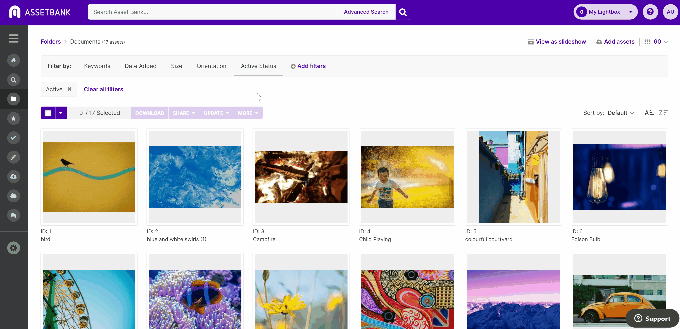
How to make the most of your online art or museum collection
Art institutions and museums are digitising their galleries but how can you create the best digital archive possible and one that fully represents your collection? An online collection of your art or museum library opens up a wealth of opportunities. By effectively digitising your collection, you can reach new audiences, keep control of asset integrity and build a long lasting resource.
How to better manage your archives
Building an online archive is an hugely worthwhile project. From providing your teams with quick and easy access to materials approved for promotional use, to allowing your patrons access to exhibition materials, a well organised archive has many benefits.
Here are some things to consider when configuring your archive:
Make sure your archive echoes your brand
You want your visitors and staff to trust the materials and resources that are stored within your collection, so ensure that your archive matches the look and feel of your other web based applications. If using a Digital Asset Management (DAM) solution, this should feel like a natural extension to your already existing online presence. Adding Custom Content Pages can be a great way to incorporate your archive into your wider online ecosystem, such as booking forms or links to donate.
Consider the browsing journey
Think about the journey you take your physical guests on when they visit your gallery or museum and consider how best to mirror this in your archive. What would be a logical structure for your users to browse through? Do you have pre-built collections or exhibitions that could act as your folder structure?
Finishing touches in this digital space are just as important as those you add to your exhibitions. What may seem like small details such as folder images and attribute icons can go a long way to visually engage your users.
Skill up on the in-app features that could help you
Features like Promoted Assets, Filter Bar and Saved Searches can greatly improve your users’ experience of your archive. Think about what your users would benefit from and the best configuration to support this.
Master search
Make your assets as easy to find as possible. Ensure you are storing the correct information about your files, without duplicating this across attribute fields which can make the upload process unnecessarily long for your staff. Building out an intelligent Filter Bar and Advanced Search page can help people find what they are looking for, fast.

Attracting new audiences
With a digital archive, it’s easy to improve the reach of your assets and really start to share them with your audience. Having a library that is available and accessible to anyone across the globe means that you can inspire audiences that potentially wouldn’t have been engaged before.
These resources also support younger audiences, particularly for educational purposes, helping the work of your museum or gallery support even when your physical doors may be closed.
The Royal Shakespeare Company (RSC) recently opened up part of its Image Library for personal use or private study, supporting theatre enthusiasts and students around the globe.
Private vs Public
As can be seen on the RSC Image Library, having an archive which is publicly available can be a great way to offer your patrons engaging resources before, after or even during their visit.
The iconic Royal Pavilion & Museum in Brighton UK, is another great example of opening up and sharing an archive. From artwork, photography, artifacts and newspapers to the latest exhibitions, the Royal Pavilion & Museum has really opened up their Asset Bank as a public image archive to maximise engagement, creating a fascinating and educational resource.
Using a Digital Asset Management system also allows you to tailor user permissions so that your staff and volunteers can access additional assets behind a login screen. You might even want to consider a cost for VIP guest access to collection materials that your patrons could purchase.
Our tips to finding the right DAM partner
We know that there are a number of similar use cases for those looking to utilise a DAM as an archive. The great thing is that many of these features and workflows will already be built in and will already start to save you time, but still make sure that you map out exactly what your requirements are. This could be the amount of storage you require to the custom attribute fields your chosen system should be able to supply. This will help you narrow down your potential suppliers, whilst keeping focused on your overall goal for the archive.
It is also important to find a supplier who can act as a true partner to bring your archive vision to life, and who can help you as you continue to curate your digital collection that benefits your staff, volunteers and visitors for years to come.
Fancy hearing how we could help digitise your art collection? Get in contact for a chat or to book a free demo.

